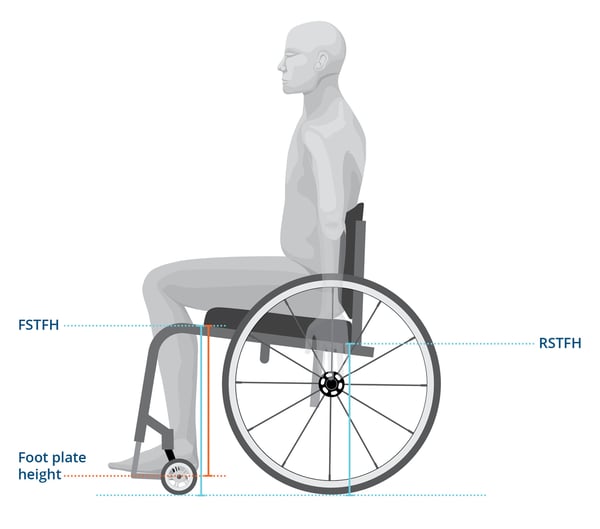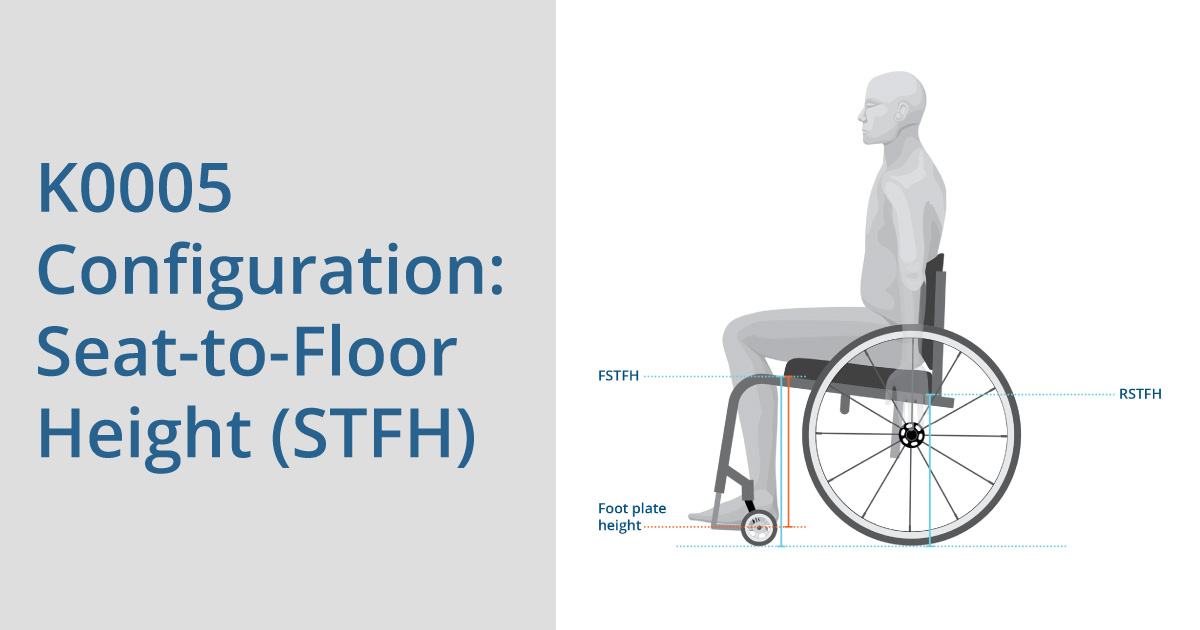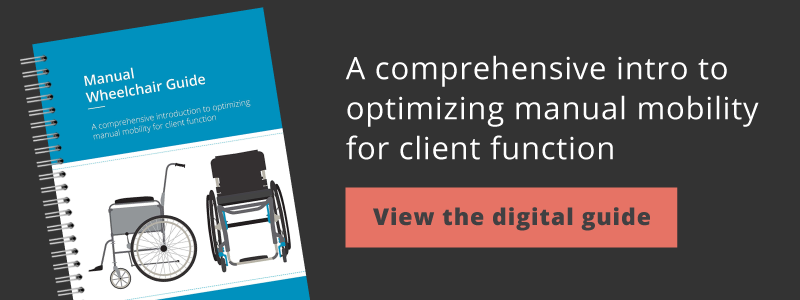This is the 5th blog in our manual wheelchair guide series.See the 1st blog, 2nd blog, 3rd blog, and 4th blog. Check out the Manual Wheelchair Guide to learn more.
As we continue our conversation about the K0005 ultra lightweight wheelchair, our focus turns to configuring a K0005 wheelchair to an individual. Today we're looking at seat-to-floor height (STFH).
Seat-to-floor height (STFH)
The front and rear seat-to-floor height is not always the same in an optimally configured K0005 manual wheelchair.

Front STFH measurement
WC measurement is from where the leading edge of the seat upholstery meets the frame of the wheelchair to the floor.
Anatomical measurement is meant to match the dimensions of the lower leg along with the foot plate to ensure lower extremity support and accessibility.
- An appropriate height will provide proper support of the thighs and lower legs to optimize stability and pressure redistribution
| * Always consider the wheelchair seat cushion thickness and clearance of tables and desks as well as transfers when measuring stfh!
For determining both the front and rear STFH, keep in mind that some seat cushions may have a different thickness in the front and the rear of the cushion. The difference will affect seat slope if not accounted for. |
Rear STFH measurement
WC measurement is from the wheelchair frame seat tube to floor, right in front of the back post. You must have the client in a WC to determine the RSTFH
- This height is meant to ensure appropriate access to wheel handrims for optimal propulsion. Optimal RSTFH is when the finger tips of the client touch the axle of the wheel.
- A lower rear STFH relative to the front STFH can provide increased postural stability for those with impaired trunk control
Foot plate height measurement
WC measurement is the distance from the top of the footplate to the seat upholstery. It should be equal to the lower leg length minus the height of the cushion.
| * USE A DEMO! All WC measurements should be completed with the client in a demo wheelchair! The demo does not have to be perfect for your client, but it will give the best reference point for fitting them. |
Join us next time in our manual wheelchair guide blog series as we go over configuring the seat slope and ergo seat in a K0005 ultra lightweight manual wheelchair.
 Stacey Mullis, OTR/ATP
Stacey Mullis, OTR/ATP
Director of Clinical Marketing
Stacey serves as Director of Clinical Marketing for Permobil. A practicing OTR for over 20 years, she has experience in school-based pediatrics, inpatient rehabilitation, long term care, and home health. With her interest in wheelchair seating and positioning, Stacey engaged the challenges of providing appropriate seating in various clinical settings. She now uses this experience to develop programs and resources to educate clinicians on the principles of seating and wheeled mobility. She is passionate about equipping clinicians and through her previous role as Director of Clinical Education with Comfort Company and now with Permobil she has taught nationally and internationally to increase therapist capacity in this specialty area. Mullis graduated from Western University in London, Ontario, Canada with a BA Linguistics and BSc Occupational Therapy. She is a member of the NCOTA, CTF Executive Board, NRRTs, RESNA, and AOTA.
 Ginger Walls, PT, MS, NCS, ATP/SMS
Ginger Walls, PT, MS, NCS, ATP/SMS
Director of Clinical Sales and Education
Ginger has 25 years of experience as a physical therapist in the area of neuro rehab and wheelchair seating/mobility. She directed the Outpatient therapy clinics and the Seating/Mobility Program at Medstar National Rehabilitation Hospital in Washington, D.C. Additionally, Ginger has provided a variety of continuing education courses and lectures in the area of seating/mobility for many years. She has presented at major industry conferences including ISS, RESNA, and the PVA Summit. Ginger took on the role of Clinical Education Specialist for Permobil in 2015 and was appointed Director of Clinical Sales and Education in 2020.

